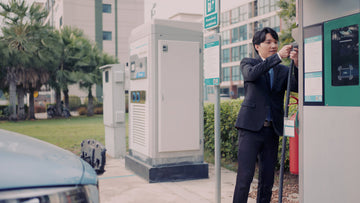
In recent years, the adoption of electric vehicles (EVs) has surged, driven by their eco-friendly attributes and potential cost savings over traditional internal combustion engine vehicles. As the popularity of EVs grows, the importance of effective charging methods and precautions becomes paramount, especially when using advanced charging solutions like those offered by Amproad. Mastering the correct and scientific approach to charging EVs is essential to ensure the longevity and optimal performance of their batteries. This article will delve into the various charging methods and precautions that EV owners, particularly those using Amproad chargers, should be aware of.
EV Charging Methods
When it comes to charging your EV, employing the correct procedures is essential for the health of the battery and the overall vehicle. Here are some essential steps for effective and safe charging, utilizing the features of Amproad chargers:
What is the Plug-In Sequence?
Begin by plugging the output plug of the Amproad charger into your EV, then connect the AC power input plug. Amproad chargers are designed to establish a stable connection quickly and safely, minimizing the risk of electrical surges. This sequence ensures that the charger and the EV are properly connected before power begins to flow, enhancing safety and efficiency.
What is the Unplugging Sequence?
Once your EV is fully charged, follow the reverse order when unplugging. First, disconnect the AC power plug, and then unplug the output plug of the Amproad charger from your vehicle. This sequence prevents any potential abrupt disconnection and ensures the safety of both the battery and charger. Unplugging in the correct order can help avoid sparks or other electrical issues.
Why Should You Avoid Over-Discharging and Over-Charging?
Amproad chargers are equipped with smart charging technology that helps prevent over-discharging and over-charging of the battery. However, it's still advised to charge frequently and avoid deep discharges to maintain optimal battery health. Over-discharging can lead to reduced battery capacity and lifespan, while over-charging can cause overheating and other safety issues.
EV Charging Precautions
To ensure a safe and effective charging experience, EV owners using Amproad chargers should observe the following precautions:
Why Should You Avoid Mid-Charging Disconnections?
Amproad chargers are designed to manage the charging process effectively. It's essential not to unplug the charging cable while it's actively charging your EV. Mid-charging disconnections can disrupt the charging cycle and potentially damage the battery or the charger. Amproad chargers ensure a smooth and safe charging process.
Should You Turn Off Car Headlights While Charging?
Yes, while charging, remember to turn off the car's headlights to optimize the charging process. Amproad chargers are optimized to prioritize power delivery to the EV battery, ensuring efficient charging. Keeping unnecessary electrical components off during charging can help the EVCS work more efficiently and reduce the overall time needed to fully charge the battery.
How Can You Minimize Internal Load During Charging?
Amproad chargers focus on providing the necessary power for charging. However, it's still a good practice to minimize activities that increase the internal charge load of the battery while charging, such as running the air conditioner or playing music. Reducing the internal load ensures that more power is directed towards charging the battery, improving charging efficiency.
Why Should You Avoid Charging During Thunderstorms?
Just as with any charging infrastructure, it's highly recommended not to charge your EV using Amproad chargers during thunderstorms. Lightning can cause electrical surges that might damage both the vehicle's electrical systems and the charging infrastructure. Waiting for the storm to pass before charging can prevent costly repairs and ensure safety.
Other Charging Considerations

In addition to the primary methods and precautions, consider the following points for a well-rounded understanding of EV charging with Amproad:
What is the Optimal Charge Level?
Amproad chargers offer features to help you maintain an optimal battery charge level. Charging your EV to around 90% is more conducive to battery health over the long term, and Amproad technology supports this approach. Keeping the battery at a slightly lower charge than full capacity can prevent over-stressing the battery cells and extend their lifespan.
How Should You Handle Long-Term Parking?
For EVs parked for an extended period, using Amproad chargers for a monthly charge is advisable. This practice prevents the battery from entering a deep discharge state, which can negatively impact its overall health. Regular charging during long-term storage keeps the battery in good condition and ready for use when needed.
Why Should You Charge Immediately at Low Power?
Amproad chargers can quickly respond to low battery levels. When your EV's battery level drops below 30%, utilizing an Amproad charger for immediate charging is recommended to prevent reduced battery lifespan and performance. Charging at low power levels helps maintain battery health and ensures that you have enough power for your next journey.
Understanding the Types of EV Chargers
Amproad offers various types of EV chargers to suit different needs. Understanding the differences between these chargers can help you choose the best one for your situation.
What is a Level 2 EV Charger?
A level 2 EV charger is a popular choice for home charging. It uses a 240-volt power source, similar to an electric dryer or oven, and provides faster charging compared to standard 120-volt outlets. This type of charger is ideal for daily use, offering a good balance between charging speed and convenience. Amproad's level 2 chargers are designed to be user-friendly and efficient, making them a great choice for most EV owners.
What is a Home Wall Charger?
A home wall charger is a dedicated charging unit installed on the wall of your garage or parking space. These chargers are usually level 2 chargers, providing quick and reliable charging for your EV. Installing a home wall charger can be a convenient and efficient solution, allowing you to charge your EV overnight or while you are at home. Amproad’s home wall chargers are built to be durable and easy to use, making home charging hassle-free.
What is a Portable EV Charger?
A portable EV charger offers flexibility and convenience, allowing you to charge your EV wherever you find a suitable power outlet. These chargers are typically slower than fixed home wall chargers but are invaluable for on-the-go charging needs. A portable EV charger can be a lifesaver during long trips or in emergencies when you don’t have access to your regular charging station. Amproad's portable EV chargers are designed to be compact and reliable, ensuring that you can charge your EV no matter where you are.
Maximizing Battery Lifespan and Efficiency with Amproad Chargers
Adopting the correct charging methods and observing necessary precautions are fundamental to maximizing the lifespan and efficiency of your EV's battery, especially when using advanced solutions like Amproad chargers. By following these guidelines and leveraging the features of Amproad technology, EV owners can contribute to a sustainable future while enjoying the benefits of electric mobility. Whether using a level 2 EV charger, a home wall charger, or a portable EV charger, understanding how to charge and maintain your EV battery properly will ensure that your vehicle remains reliable and efficient for years to come.
Mastering the use of your Amproad charger, being mindful of charging sequences, and adhering to safety precautions are all crucial steps in the responsible ownership of an EV. With the right knowledge and tools, you can ensure that your EV is always ready to go, supporting your journey towards greener and more efficient transportation.


